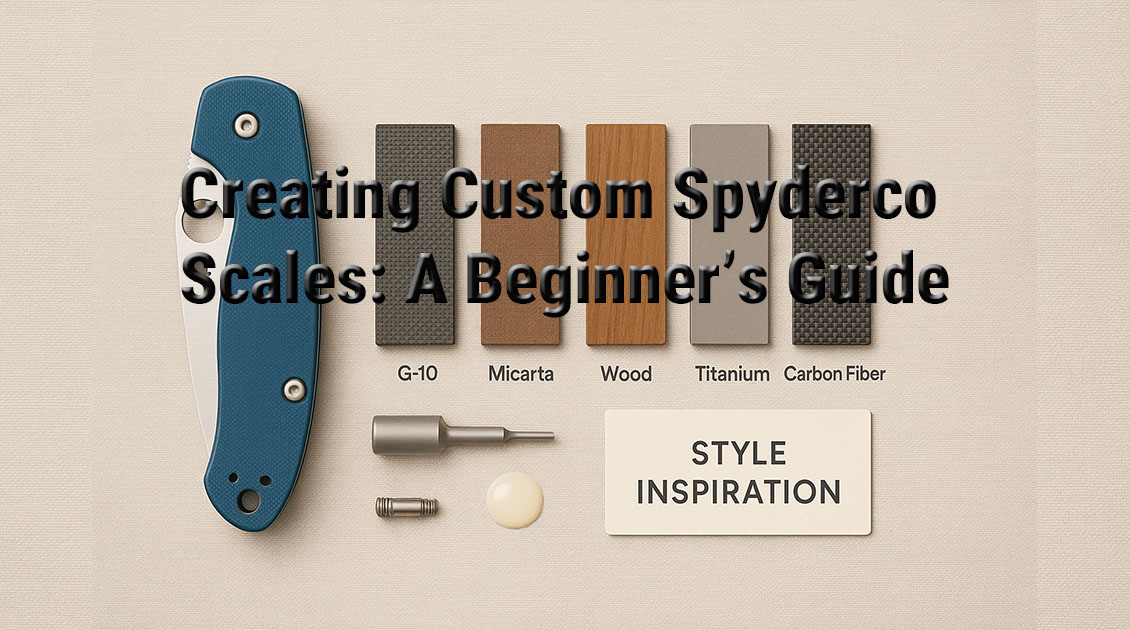Creating Custom Spyderco Scales: A Beginner’s Guide

This is the 30th blog of the Spyderco blog series. You can check the other blogs I wrote from here – https://spydercoparts.com/blogs
By Logan M. Fraser
Custom Knife Modder & Spyderco Parts Specialist
Based in Calgary, Alberta, Canada
Why Custom Spyderco Scales Are Worth the Effort
Creating custom Spyderco scales is one of the most rewarding ways to personalize your knife. Whether you’re after better ergonomics, enhanced grip, or a visual refresh, upgrading your Spyderco with new scales brings the knife closer to your identity. As someone who’s customized hundreds of Spydercos in my Calgary workshop, I can assure you that even beginners can make impressive upgrades with the right guidance and patience.
What Are Spyderco Scales, and Why Replace Them?
The scales are the handle sides attached to the knife’s steel liners. Spyderco typically uses materials like G-10, FRN, carbon fiber, or titanium. While factory scales are designed for mass production, they don’t always satisfy individual preferences. Maybe they feel too smooth, too bulky, or lack flair.
Customizing scales allows you to:
-
Adjust grip texture or shape for comfort
-
Reduce weight with different materials
-
Add aesthetic appeal with unique designs or colors
-
Complement other mods (like aftermarket clips or backspacers)

Before You Begin: What You’ll Need
To start creating or installing custom scales, you’ll need:
Tools
-
Torx driver set (usually T6, T8, and sometimes T10)
-
Bench vise or clamps
-
Small hammer (for press-fitting pivot barrels)
-
Sandpaper (100 to 1000 grit)
-
Dremel or rotary tool (for detailed shaping)
-
Safety goggles and gloves
Materials
-
Scale blanks (Micarta, G-10, carbon fiber, wood, titanium, etc.)
-
Templates or original Spyderco scales for tracing
-
Epoxy or industrial adhesive (if required)

Step-by-Step Guide to Creating Your Custom Spyderco Scales
1. Choose Your Model Wisely
Start with a model that has plenty of modding support. The Paramilitary 2, Para 3, and Manix 2 are popular because of their accessible hardware and modular construction.
2. Disassemble the Knife Carefully
Use the correct Torx size and lay out your parts methodically. Be especially cautious with washers and detent balls. Take photos as you go—they’ll help during reassembly.
3. Trace or CAD the Scale Pattern
Place the factory scales over your blank material and trace the outline. For more precision, consider using a digital caliper and CAD software (Fusion 360 or Inkscape) if you have access to a CNC router or laser cutter.
4. Cut and Shape the Scales
Use a bandsaw, scroll saw, or rotary tool to rough out the shape. Refine the edges with sanding blocks or files.

5. Drill and Fit Mounting Holes
Mark and drill holes for screws, pivot, and lanyard. Precision is key. Always drill pilot holes before widening. Align your new scales with the factory ones to double-check accuracy.
6. Test Fit and Fine-Tune
Install the knife with the new scales without applying any glue or threadlocker. This test fit helps spot misalignments. Make necessary adjustments now before the final assembly.
7. Finishing Touches
Sand the scales progressively with finer grits. If using wood, apply a finish like tung oil or polyurethane. For Micarta or G-10, a light buffing can enhance the texture.
Common Mistakes and How to Avoid Them
 Over-tightening Screws
Over-tightening Screws
This can strip threads or warp the scale. Use gentle pressure and consider a torque driver.
 Poor Alignment
Poor Alignment
Improper hole placement ruins the whole effort. Use factory scales as alignment guides and triple-check measurements.
 Choosing the Wrong Material
Choosing the Wrong Material
Some materials are beautiful but impractical (like soft wood without stabilization). Research your material before starting.
Should You Buy or Make Custom Scales?
If you’re short on time or tools, buying custom scales might be the better route. Handmade titanium or CNC-milled G-10 scales from small makers can still give your knife that unique touch. Just make sure you’re buying from reputable sites. Many of my customers pair these upgrades with precision-fit parts from SpydercoParts.com to finish the mod cleanly.

Is It Legal to Modify Your Knife?
In most places, modifying your own knife for personal use is legal. However, if you plan to sell or gift it, ensure it complies with local knife laws. For example, Canadian knife laws restrict certain blade types and deployment mechanisms. When in doubt, check the Government of Canada’s regulations on prohibited weapons.
My Favorite Custom Scale Builds (and Lessons Learned)
-
Micarta Para 3 for Winter EDC
Grippy even with gloves on. I learned to add a shallow finger groove for extra control. -
Brass-Backed PM2 with Flame-Anodized Bolts
A visual masterpiece but too heavy for pocket carry. Looks cool on the shelf, though! -
Wooden Manix 2 with Carved Texture
Soft woods crack under torque. I had to stabilize the blanks with resin.
Wrapping It Up
Custom Spyderco scales are more than cosmetic—they improve function, reflect your taste, and make your knife truly yours. Whether you start from scratch or swap in pre-made ones, the process is a rewarding way to understand your blade better.


Sources & Resources
-
SpydercoParts.com — Replacement screws, clips, backspacers, and mod kits
-
BladeForums — Knife modding community and tutorials
-
Canadian Weapons Law – Justice.gc.ca — For understanding knife law boundaries



